World Diabetes Day is observed globally on 14th November. The Day is observed every year to increase the awareness and focus on diabetes mellitus. Diabetes, also known as diabetes mellitus, is a group of common endocrine diseases characterized by sustained high blood sugar levels in human body. Read the complete article to know the details about what is Diabetes, symptoms of Diabetes, types of diabetes and foods for diabetics.
World Diabetes Day
World Diabetes Day was launched in 1991 by the International Diabetes Federation and the World Health Organization (WHO) in response to the rapid rise of diabetes around the world. Diabetes is due to either the pancreas not producing enough insulin, or the cells of the body not responding properly to the insulin produced. Diabetes, if left untreated, leads to many health complications. Untreated or poorly treated diabetes accounts for approximately 1.5 million deaths per year.
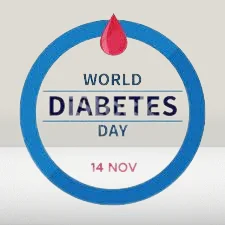
What is Diabetes
What is Diabetes ? Diabetes in our body is a health condition when the blood sugar or blood glucose level is too high. Glucose is our body’s main source of energy. Our body can make glucose but also we get glucose from the foods we eat. One of our internal body part in our body “the Pancreas” make a hormone named “Insulin” which helps glucose get into our body cells to be used for energy.
We suffered from Diabetes when our body does not make enough Insulin or does not use Insulin properly. As a result of which the glucose or blood sugar in our body can not be used by the cells for making energy, and hence these glucose stays in our blood and doesn’t reach the cells and glucose builds up in our bloodstream, causing high blood sugar (hyperglycemia). Glucose (sugar) mainly comes from carbohydrates in your food and drinks. It’s your body’s go-to source of energy. Your blood carries glucose to all your body’s cells to use for energy.
Under normal circumstances, insulin functions in the following steps:
- our body breaks down the food we eat into glucose (sugar), which is our body’s main source of energy.
- Glucose enters our bloodstream, which signals our pancreas to release insulin.
- Insulin helps glucose in our blood enter our muscle, fat and liver cells so they can use it for energy or store it for later use.
- When glucose enters our cells and the levels in our bloodstream decrease, it signals our pancreas to stop producing insulin.
Diabetes raises the risk for damage to the eyes, kidneys, nerves, and heart. Diabetes is also linked to some types of cancer. Taking steps to prevent or manage diabetes may lower your risk of developing diabetes health problems. Over time, having consistently high blood glucose can cause health problems, such as heart disease, nerve damage and eye issues.
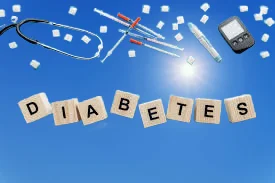
Over time, high blood glucose can damage our heart, kidneys, feet, and eyes. If we have diabetes, we can take steps to lower your chances of developing diabetes health problems by taking steps to improve our health and learning how to manage the disease. Managing our blood glucose, blood pressure, and cholesterol levels can help prevent future health problems.
The technical name for diabetes is diabetes mellitus. Another condition shares the term “diabetes” — diabetes insipidus — but they’re distinct. They share the name “diabetes” because they both cause increased thirst and frequent urination. Diabetes insipidus is much rarer than diabetes mellitus.
Types of Diabetes
Let us know the most common types of Diabetes on this World Diabetes Day. The most common types of diabetes are type 1, type 2, and gestational diabetes.
Type 1 diabetes
If we have type 1 diabetes, our body makes little or no insulin. Our immune system attacks and destroys the cells in our pancreas that make insulin. Type 1 diabetes is usually diagnosed in children and young adults, although it can appear at any age. People with type 1 diabetes need to take insulin every day to stay alive. Type 1 diabetes is the most dangerous types of diabetes as it not curable.
Type 2 diabetes
If we have type 2 diabetes, the cells in our body don’t use insulin properly. The pancreas may be making insulin but is not making enough insulin to keep our blood glucose level in the normal range. Type 2 diabetes is the most common type of diabetes. We are more likely to develop type 2 diabetes if we have risk factors, such as overweight or obesity, and a family history of the disease. We can develop type 2 diabetes at any age, even during childhood.
We can help delay or prevent type 2 diabetes by knowing the risk factors and taking steps toward a healthier lifestyle, such as losing weight or preventing weight gain.
Gestational diabetes
Gestational diabetes is a type of diabetes that develops during pregnancy. Most of the time, this type of diabetes goes away after the baby is born. However, if we’ve had gestational diabetes, we have a higher chance of developing type 2 diabetes later in life. Sometimes diabetes diagnosed during pregnancy is type 2 diabetes.
Prediabetes
People with prediabetes have blood glucose levels that are higher than normal but not high enough to be diagnosed with type 2 diabetes. If we have prediabetes, we have a higher risk of developing type 2 diabetes in the future. We also have a higher risk for heart disease than people with normal glucose levels.
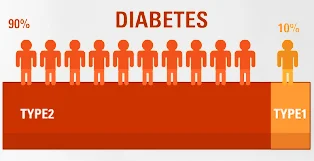
Diabetes is common. Approximately 37.3 million people in the United States have diabetes, which is about 11% of the population. Type 2 diabetes is the most common form, representing 90% to 95% of all diabetes cases.
About 537 million adults across the world have diabetes. Experts predict this number will rise to 643 million by 2030 and 783 million by 2045.
Cardiovascular (heart and blood vessel) issues are the most common type of long-term diabetes complication. They include Coronary artery disease, Heart attack, Stroke, Atherosclerosis. Other diabetes complications include Nerve damage (neuropathy), which can cause numbness, tingling and/or pain, Nephropathy, which can lead to kidney failure or the need for dialysis or transplant, Retinopathy, which can lead to blindness, Diabetes-related foot conditions, Skin infections, Amputations, Sexual dysfunction due to nerve and blood vessel damage, such as erectile dysfunction or vaginal dryness, Gastroparesis, Hearing loss and also oral health issues, such as gum (periodontal) disease.
Symptoms of Diabetes
On this World Diabetes Day let us know the Symptoms of Diabetes which includes
- Increased thirst (polydipsia) and dry mouth.
- Frequent urination.
- Drowsiness or Fatigue.
- Blurred vision.
- Unexplained weight loss.
- Numbness or tingling in your hands or feet.
- Slow-healing sores or cuts.
- Frequent skin and/or vaginal yeast infections.
- Dry, itchy skin
- Type 2 diabetes can cause discolored patches in the folds of skin in our armpits and neck.
- Additional symptoms of diabetics include vomiting, stomach pains, fruity-smelling breath and labored breathing.
- Another possible sign of prediabetes is darkened skin on certain parts of our body.
Tests for Diabetes
A1C Test
The A1C test measures our average blood sugar level over the past 2 or 3 months. An A1C below 5.7% is normal, between 5.7 and 6.4% indicates we have prediabetes, and 6.5% or higher indicates we have diabetes.
Fasting Blood Sugar Test
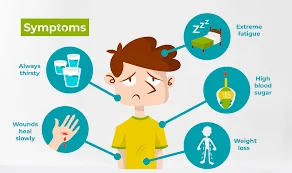
This measures our blood sugar after an overnight fast (not eating). A fasting blood sugar level of 99 mg/dL or lower is normal, 100 to 125 mg/dL indicates we have prediabetes, and 126 mg/dL or higher indicates we have diabetes.
Glucose Tolerance Test
This measures our blood sugar before and after you drink a liquid that contains glucose. We’ll fast (not eat) overnight before the test and have our blood drawn to determine our fasting blood sugar level. Then we’ll drink the liquid and have our blood sugar level checked 1 hour, 2 hours, and possibly 3 hours afterward. At 2 hours, a blood sugar level of 140 mg/dL or lower is considered normal, 140 to 199 mg/dL indicates we have prediabetes, and 200 mg/dL or higher indicates we have diabetes.
Random Blood Sugar Test
This measures our blood sugar at the time we’re tested. We can take this test at any time and don’t need to fast (not eat) first. A blood sugar level of 200 mg/dL or higher indicates we have diabetes.
| Result* | Diabetes | Prediabetes | Normal |
| A1C Test | 6.5% or above | 5.7 – 6.4% | Below 5.7% |
| Fasting Blood Sugar Test | 126 mg/dL or above | 100 – 125 mg/dL | 99 mg/dL or below |
| Glucose Tolerance Test | 200 mg/dL or above | 140 – 199 mg/dL | 140 mg/dL or below |
| Random Blood Sugar Test | 200 mg/dL or above | N/A | N/A |
Treatment and Precautions
Based on the test reports, the physician can prescribe the desired medications and timely tests with follow up required.
There’s no cure for type 1 diabetes. Taking Insulin is the only option. It requires lifelong disease management. But with consistent monitoring and adherence to treatment, we may be able to avoid more serious complications of the disease.
If we work closely with our doctor and make healthy lifestyle choices, type 2 diabetes can often be successfully managed or even reversed.
If we have gestational diabetes, it will likely resolve after our baby is born. However, we do have a higher risk of developing type 2 diabetes later in life.
Lifestyle Changes
- Take meals same time every day. Blood sugar levels rise after meals and then fall. Eating as per schedule ensures you avoid major fluctuations in blood sugar levels.
- As much as possible, eat a well-balanced diet consisting of complex carbohydrates, proteins, fruits and vegetables.
- Control the portion size of food. Avoid overindulgence in any kind of food.
- Maintain proper timing for medicines and meals. Too long a gap will cause dangerously low blood sugar (hypoglycemia).
- Follow a proper exercise schedule in terms of best time of the day to exercise and type of exercises we can do. Walking, swimming or cycling will keep weight in check.
- Drink plenty of water throughout the day to avoid dehydration.
- If insulin-dependent, then store the drug properly and check the expiry date.
- Keep those who are close at work and home, informed about the medicines and how to handle any crisis situation.
- Even when under stress either due to work pressure or family issues, don’t divert from normal activity and eating schedule.
- Keep light snacks in easy reach.
- Say no to smoking, alcohol, fizzy drinks and even diet cokes etc.
- Learn relaxation techniques like meditation to stay de-stressed.
- Avoid a sedentary lifestyle like watching TV or working on the laptop for long hours.
- Be careful of any injuries or falls.
- Limit sugar, white flour and other refined grains, and starchy vegetables, which can spike blood glucose levels. Instead, choose non-starchy vegetables and whole grains as much as possible.
- Excess weight can make diabetes symptoms worse, and losing just 5 to 7 percent of body weight can help regulate blood sugar levels and improve insulin resistance.
Foods for Diabetes
Below you will find the most suitable foods for diabetics patients.
Starches
These are a type of carbohydrate, which is the main source of energy for your body. Starches are also called complex carbs, which provide vitamins, minerals, and fiber. Grains, beans, and vegetables all contain starches. But some starches are better for you if you have diabetes.
Best starch choices may include:
- Whole grains, such as brown rice, oatmeal, or quinoa
- Baked sweet potato
- Plain porridge
- Seeded breads, including loaves with flax, chia, sunflower, or pumpkin seeds
- Whole wheat pita or roti
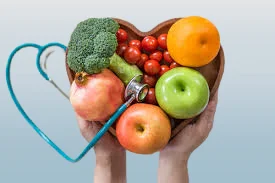
Try to limit highly processed starches, such as:
White rice and white flour
Naan bread made from refined flour
Fried yuca fries
Fried white-flour tortilla chips
Sugary foods can cause dangerous spikes in your blood sugar levels. And high blood sugar over time can lead to serious diabetes complications. Carbohydrates found in most vegetables and whole grains don’t affect blood sugar as much. And even though they are needed for energy, carbs like sugar don’t always help.
Best options for sweets include:
- Fresh juice, like orange or passionfruit
- Foods with low carbs, like strawberry salsa in small portions
- Desserts with more natural sweeteners
Worst Choices
- Regular pancake or waffle syrup
- Deep-fried desserts, like churros or funnel cakes
- Candy
- Cookies
- Tarts and puddings
Best Choices in vegetables
- Fresh veggies — raw, lightly steamed, roasted, or grilled
- Plain frozen vegetables, lightly steamed
- Greens such as kale, spinach, and arugula
- Tabouli and other types of nutrient-rich salads
- Low-sodium or unsalted canned vegetables
Worst Choices in vegetables
- Canned vegetables with lots of added sodium (or salt)
- Veggies cooked with lots of added butter, cheese, or sauce
- Pickles with high sodium
- Sauerkraut, for the same reason as pickles. Limit them if you have high blood pressure.
Best Choices in fruits
- Fresh fruit
- Plain frozen fruit or fruit canned without added sugar
- Jam, jelly, or preserves with little or no sugar
- Applesauce with no added sugar
Worst Choices in fruits
- Canned fruit with heavy sugar syrup
- Chewy fruit rolls
- Regular jam, jelly, and preserves (unless you have a very small portion)
- Sweetened fruit gummies
Best Choices in Protein
- Plant-based proteins such as beans, nuts, seeds, or fresh tofu
- Fish and seafood
- Chicken and other poultry
- Eggs
If you eat meat, keep it low in fat. Trim the skin off of poultry. Try to include some plant-based protein, even if you’re not a vegetarian or vegan. You’ll get nutrients and fiber that aren’t in animal products.
Worst Choices in Protein
- Fried meats
- Higher-fat cuts of meat, such as ribs
- Pork bacon
- Regular cheeses
- Poultry with skin
- Deep-fried fish or tofu
- Beans prepared with lard
Best Choices in oil and fats
- Natural sources of vegetable fats, such as nuts, seeds, or avocados (high in calories, so keep portions small)
- Foods that give you omega-3 fatty acids, such as salmon, tuna, or mackerel
- Canola, grapeseed, or olive oils
Worst Choices in oil and fats
- Partially hydrogenated foods
- Solid margarines
- Vegetable shortening
- Red meat
- Coconut oil
- Palm oil
- Bacon grease
The best types of dairy products if you have diabetes are low-fat and nonfat options. These include low-fat Greek yogurt, nonfat milk, and various kinds of dairy milk alternatives (such as oat, almond, soy, or even macadamia milk). If you are unsure whether something has too much dairy in it, check the nutrition label for calcium. Your doctor can tell you how much you need each day.
Other dairy products, like whole or 2% milk, creme fraiche, and high-fat cheeses can be bad for you if you have diabetes. Certain non-dairy alternatives, like solid margarine, are also not the best choice.
Best Choices in drinks
- Coffee, black or with added low-fat milk and sugar substitute
- Water
- Unsweetened tea with or without a slice of lemon
- Sweet lassi with low sugar
- Light beer, small amounts of wine, or non-fruity mixed drinks
- Zero-calorie sodas
Worst Choices in drinks
- Coffee with cream or sugar
- Flavored coffees and chocolate drinks
- Regular sodas
- Regular beer, fruity mixed drinks, dessert wines
- Sweetened tea
- Energy drinks
- Fruit punch or other processed fruit-juice drinks
10 best foods for diabetics to control Diabetes and Blood sugar
Non-Starchy Vegetables
- Artichokes
- Asparagus
- Avocados
- Broccoli
- Cabbage
- Cauliflower
- Celery
- Cucumbers
- Green Beans
- Hearts of Palm
- Mushrooms
- Olives
- Onions
- Squashes
- Tomatoes
- Zucchini
Leafy Greens – Many of the best leafy greens are considered non-starchy vegetables. Leafy greens are packed full of nutrients and are lower in digestible carbs than other vegetables. Some of the best leafy greens to incorporate into your daily diet are spinach and kale, as they have very high levels of vitamin C.3 Vitamin C helps to manage diabetes in people with type 2 diabetes and can help promote an overall sense of wellbeing.
Fatty Fish – It’s one of the healthiest foods that you can eat and has a myriad of benefits. Fatty fish like salmon and anchovies give you a significant serving of the omega-3 fatty acids DHA and EPA, which can help protect your heart against potential complications from diabetes.
Nuts and Eggs – Other fatty foods that help control diabetes and help blood sugar management are nuts and eggs. The best types of nuts for diabetics include almonds, brazil nuts, cashews, hazelnuts, macadamia nuts, pecans, pistachios, and walnuts. Eggs are also a great source of healthy fats that are beneficial in controlling diabetes. They can actually improve your insulin sensitivity and decrease inflammation while simultaneously providing antioxidant benefits that help reduce the amount of free radicals in your body and protect against disease.
Seeds – Certain types of seeds are known to control diabetes. The two best seeds to eat as a diabetic are chia seeds and flax seeds. Chia seeds are packed with fiber, low in digestible carbs, and have been found to actually lower your blood sugar levels. Flaxseeds are also beneficial as they can help improve blood sugar control, decrease your risk of heart disease, and lower the chance of having a stroke. Since flaxseeds can be difficult to absorb, opt for ground seeds or make sure to take the time and grind them up at home before eating them. Ingesting whole flax seeds won’t give you any benefits.
Natural Fats – Extra-virgin olive oil is one of the most effective oils at reducing the risk of heart disease and contains a number of antioxidants that help to reduce inflammation, protect your cells, and decrease blood pressure. Other natural fats that are helpful at controlling diabetes include coconut oil, avocado oil, any type of nut oil, lard, tallow, chicken fat, duck fat, coconut milk, and unsweetened coconut cream.
Apple Cider Vinegar – Apple cider vinegar is popular amongst health food fanatics for a good reason. The fermented acetic acid helps to improve insulin sensitivity, lower fasting blood sugar levels, and reduce blood sugar response by as much as 20% when paired with meals that are rich in carbs. Due to the high acidity of apple cider vinegar, it’s best taken by the tablespoon mixed with water to avoid damaging your teeth and esophagus. Start slowly, with about one teaspoon, and work your way up based on how you feel.
Cinnamon and Turmeric – Both cinnamon and turmeric should be incorporated into your diet daily to get the best results. Cinnamon can be added to almost any food or drink to increase the flavor. Cinnamon has been shown to help regulate blood sugar levels, improve insulin sensitivity, and reduce hemoglobin A1c levels. Turmeric also lowers inflammation and blood sugar levels, reduces your risk of developing heart disease, and benefits kidney health. Just make sure that you mix your turmeric with black pepper to activate the beneficial ingredient curcumin.
Probiotic Packed Dairy Foods – If you add any diary to your diet, make sure that it’s packed with healthy probiotics for the biggest benefits to your health. Greek yogurt is a great option since it’s low in sugar and high in probiotics. In studies done, Greek yogurt was found to improve blood sugar control and even reduce heart disease risks. Aim for unflavored Greek yogurt as the flavored versions are much higher in sugar and more processed, therefore may contribute to an increase in blood sugar.
Strawberries – Strawberries are loaded with antioxidants and have been shown to reduce both cholesterol and insulin levels after a meal. If you’re not a fan of strawberries and want to incorporate daily fresh fruit into your diet, opt for raspberries, blueberries, or blackberries, which tend to have lower sugar content than other fruits like apples and bananas.
The above foods for diabetics can be used regularly in daily routine to manage the levels of blood sugar effectively.
As a whole, Diabetes, Blood Pressure, Cholesterol are some of the major health implications faced by millions globally. We must be aware and take necessary precautions to maintain a healthy life.
Hope you liked the article, what is Diabetes, symptoms of Diabetes, types of diabetes and foods for diabetics. . Thank you for visiting read4knowledge. CLICK HERE to read more interesting articles.
1 thought on “World Diabetes Day, 14th November, What is Diabetes? Types of Diabetes, Causes, Symptoms, Precautions and Treatments”